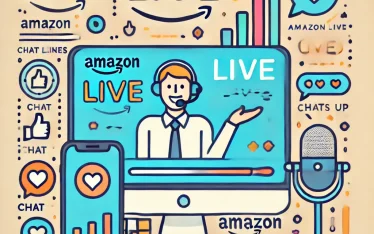As sellers strive to make their mark in the competitive landscape of the world’s largest online marketplace, according to our Amazon consulting experts, understanding and harnessing the power of Amazon’s Pay-Per-Click (PPC) advertising is not just an advantage; it’s a necessity. In this blog, we embark on a journey to unravel the strategies, insights, and nuances that will empower you to unlock the full potential of Amazon Ads PPC.
From demystifying the basics to delving into advanced tactics, we’ll navigate the intricate world of paid advertising on Amazon, helping you drive traffic, boost sales, and elevate your products above the digital noise. Whether you’re a seasoned seller looking to refine your PPC strategy or a newcomer eager to make a splash, join us as we unravel the keys to effective Amazon PPC Advertising, guiding you towards a new realm of visibility and success.
What is Amazon PPC?
You might have heard of Amazon PPC services in passing. But what exactly is it? Amazon PPC, or Pay-Per-Click advertising, is a marketing model on the Amazon platform where advertisers pay a fee each time their ad is clicked. It’s a form of online advertising that allows sellers to promote their products directly within Amazon’s search results and product detail pages. The goal of Amazon PPC is to increase product visibility, drive targeted traffic to product listings, and ultimately boost sales.
How does Amazon PPC work?
Now that you have an understanding of Amazon PPC, you must be curious about how to work around Amazon PPC. Here’s a brief overview of how Amazon PPC works:
1. Ad Creation:
- Sellers create and set up ads through the Amazon Advertising platform.
- Advertisers can choose from various ad types, including Sponsored Products, Sponsored Brands, and Sponsored Display Ads.
2. Keyword Targeting:
- Advertisers select relevant keywords for their products. When shoppers search for these keywords on Amazon, the ads may appear in the search results.
3. Bid Amount:
- Sellers set a bid amount, which represents the maximum amount they are willing to pay when a shopper clicks on their ad.
4. Auction System:
- When a shopper enters a search query matching the chosen keywords, Amazon runs an auction to determine which ads will be displayed.
- The auction considers both bid amounts and the relevance of the ad (determined by factors like click-through rate and historical performance).
5. Ad Placement:
- Winning bids secure ad placement, and the selected ad appears in prominent positions on the search results page or product detail pages.
6. Cost per Click (CPC):
- Advertisers are charged only when a shopper clicks on their ad, hence the term Pay-Per-Click.
- The cost per click varies based on the bid amount, competition, and the quality of the ad.
7. Campaign Monitoring and Optimization:
- Advertisers continuously monitor the performance of their campaigns through the Amazon Advertising dashboard.
- Optimization involves adjusting bids, refining keyword targeting, and making strategic changes based on performance data.
Amazon PPC: Benefits & challenges
Just like any other marketing strategy, Amazon PPC also has its benefits and challenges. Here’s a list of the good… and the not so good.
| Benefits of Amazon PPC | Challenges of Amazon PPC |
| 1. Increased Visibility: PPC ads boost product visibility, especially for new or less-established products. | 1. Cost: Click costs can add up, and without proper management, campaigns may become expensive. |
| 2. Targeted Advertising: Advertisers can target specific keywords, demographics, and shopper behaviours. | 2. Learning Curve: For beginners, understanding and optimising PPC campaigns can be complex and time-consuming. |
| 3. Flexible Budgets: Sellers can set daily or campaign budgets, providing control over advertising costs. | 3. Competition: In highly competitive markets, winning the bid for top placements can be challenging and costly. |
| 4. Immediate Results: PPC campaigns can generate immediate traffic and sales for promoted products. | 4. Dependency: Relying solely on PPC without other marketing efforts may not lead to sustainable long-term success. |
| 5. Performance Data: Detailed analytics provide insights into campaign performance, enabling strategic adjustments. | 5. Click Fraud: In some cases, competitors or malicious actors may engage in click fraud, affecting campaign metrics. |
| 6. A/B Testing: Advertisers can test different ad creatives, keywords, and strategies to optimise campaign performance. | 6. Ad Fatigue: Overexposure to the same ads may lead to reduced effectiveness and ad fatigue among users. |
| 7. Seasonal Promotions: Ideal for promoting seasonal or time-sensitive products and capitalising on trends. | 7. Ad Blockers: Some users may use ad blockers, limiting the reach of PPC campaigns. |
| 8. Product Launch Support: Effective for launching new products and gaining initial visibility. | 8. Organic Rankings: Over Reliance on PPC may result in neglecting efforts to improve organic search rankings. |
| 9. Customizable Ad Types: Various ad formats cater to different marketing goals, including Sponsored Products, Brands, and Display Ads. | 9. Algorithm Changes: Changes in Amazon’s algorithms or policies may impact the effectiveness of PPC campaigns. |
Understanding and considering these benefits and challenges allows sellers to make informed decisions about incorporating Amazon PPC into their overall marketing strategy and optimising their campaigns for success.
How much does Amazon PPC cost?
It is not easy to determine the exact pricing of Amazon PPC as it operates on a bidding system, where sellers set a maximum bid for their chosen keywords. The cost per click (CPC) is influenced by several factors:
Bid Amounts:
Sellers decide how much they are willing to pay for a click on their ad. Higher bids increase the likelihood of winning the auction for ad placement.
Competition:
Popular and competitive keywords often have higher CPCs due to increased demand. Niche or less competitive keywords may offer more cost-effective options.
Ad Relevance and Quality:
Amazon considers the relevance and quality of ads when determining ad placement. High-quality, relevant ads may achieve better positions with lower CPCs.
Campaign Objectives:
The goals of the PPC campaign, such as brand awareness, product launch, or driving sales, influence bid strategies and, consequently, costs.
Historical Performance:
Amazon assesses the historical performance of ads, considering factors like click-through rates (CTR) and conversion rates. Well-performing ads may have a positive impact on costs.
Seasonality and Trends:
Costs may fluctuate based on seasonal demand, trends, or external factors. Understanding market dynamics is crucial for budget planning.
What are the types of Amazon PPC?
As sellers embark on the journey of promoting their products, understanding the different types of Amazon PPC campaigns is essential. In this guide, we’ll explore the diverse universe of Amazon PPC campaigns, each tailored to meet specific marketing objectives and drive success.
1. Sponsored Products Campaigns:
Objective: Increase visibility for individual products.
Placement: Sponsored Products appear within search results and on product detail pages.
Targeting: Keyword targeting allows ads to show when shoppers search for selected keywords.
2. Sponsored Brands Campaigns:
Objective: Build brand awareness and promote multiple products.
Placement: Sponsored Brands appear at the top of search results, featuring a custom headline, logo, and multiple products.
Targeting: Keyword targeting and audience targeting based on interests or behaviours.
3. Sponsored Display Campaigns:
Objective: Retargeting and reaching potential customers beyond Amazon.
Placement: Ads are displayed on and off Amazon, targeting shoppers who viewed product detail pages.
Targeting: Product targeting and audience targeting based on interests and behaviours.
4. Product Attribute Targeting:
Objective: Targeting competitors or similar products.
Placement: Ads appear on product detail pages of targeted products.
Targeting: Based on specific product categories, brands, or individual ASINs (Amazon Standard Identification Numbers).
5. Lock Screen Ads Campaigns:
Objective: Engage shoppers through ads on Kindle E-readers and Fire Tablets.
Placement: Displayed on Kindle E-reader and Fire Tablet lock screens.
Targeting: Keywords, interests, and product targeting.
6. Video Ads Campaigns:
Objective: Convey a compelling message through video content.
Placement: Featured on product detail pages, in search results, and on the Amazon homepage.
Targeting: Manual targeting using keywords, products, or interests.
7. Dynamic ASIN Targeting:
Objective: Automatically target related products based on a product’s characteristics.
Placement: Ads appear on product detail pages of dynamically chosen products.
Targeting: Automatic targeting based on product attributes.
8. Category Targeting:
Objective: Target products within specific Amazon categories.
Placement: Ads appear on product detail pages within the selected category.
Targeting: Manual targeting based on broader product categories.
How to start PPC on Amazon?
Running a successful PPC (Pay-Per-Click) campaign on Amazon involves several key steps. Here’s a comprehensive guide to help you navigate the process:
1. Set Up Your Amazon Advertising Account:
- If you don’t have an Amazon Advertising account, sign up for one.
- Access your Seller Central account and navigate to the “Advertising” tab.
2. Choose the Right Campaign Type:
- Select the type of PPC campaign that aligns with your goals (Sponsored Products, Sponsored Brands, Sponsored Display, etc.).
- Consider your objectives, target audience, and product promotion strategy.
3. Identify Your Campaign Goals:
Define clear objectives for your campaign, such as increasing product visibility, driving sales, or launching a new product.
4. Keyword Research:
- Conduct thorough keyword research to identify relevant and high-performing keywords for your products.
- Utilise tools like Amazon’s Keyword Planner, third-party tools, and competitor analysis.
5. Create Compelling Ad Content:
- Craft engaging ad headlines, product descriptions, and include high-quality images.
- For Sponsored Brands and Sponsored Display, create a visually appealing brand message.
6. Set Your Budget:
- Determine your daily or campaign budget to control spending.
- Allocate budgets based on the products you want to promote and their respective goals.
7. Choose Bidding Strategy:
- Decide between automatic and manual bidding based on your expertise and campaign goals.
- Manual bidding allows more control over bid amounts for keywords.
8. Select Targeting Options:
Define your targeting options based on campaign type:
- For Sponsored Products, choose between automatic and manual targeting.
- For Sponsored Brands, select keywords and set bids.
- For Sponsored Display, choose audience targeting and product targeting.
9. Monitor and Adjust Campaign Settings:
- Regularly review your campaign performance metrics, including impressions, clicks, and conversions.
- Adjust bids, pause underperforming keywords, and optimise targeting based on data.
10. Optimise Landing Pages:
- Ensure that your product detail pages are optimised for conversions.
- Improve product titles, descriptions, and images to enhance the customer experience.
11. Evaluate Performance Data:
- Analyse key performance indicators (KPIs) like click-through rate (CTR), conversion rate, and advertising cost of sales (ACoS).
- Identify trends, patterns, and opportunities for improvement.
12. Refine and Scale:
- Based on the performance data, refine your campaign strategy.
- Scale successful campaigns by increasing budgets or expanding keyword targeting.
13. Experiment with Ad Types:
- Test different ad types, such as video ads, to see which resonates best with your audience.
- Explore new features and offerings within the Amazon Advertising platform.
14. Stay Informed About Amazon Policies:
- Regularly check Amazon’s advertising policies to ensure compliance.
- Stay informed about updates, new features, and changes in the Amazon Advertising platform.
As we conclude this exploration into the realm of Amazon PPC, it’s evident that mastering the intricacies of pay-per-click advertising is a dynamic journey. The steps outlined in this guide serve as a roadmap, guiding you through the process of setting up and managing successful PPC campaigns on the world’s largest e-commerce platform.
As you navigate your way through the world of Amazon PPC, stay attuned to your campaign metrics, experiment with different strategies, and embrace a mindset of continuous improvement. Whether you’re a seasoned seller looking to optimise your advertising efforts or a newcomer eager to make a splash, may your journey through Amazon PPC optimization be marked by strategic victories, data-driven insights, and a lasting impact on your brand’s success. If you have any doubt, feel free to access our Amazon experts. Happy advertising!











About The Author
Jimi Patel
Jimi Patel, is a Co-founder and CEO at eStore Factory, an Amazon SPN certified agency that serves as a one-stop solution for all your Amazon business needs. Having helped countless brands increase sales and grow their footprint on Amazon, Jimi provides the most practical and effective solutions for your business. He is highly skilled in developing and executing plans that align with your specific business goals and objectives. When not working, Jimi enjoys practicing yoga and traveling to new places. He is an avid reader and enjoys staying up-to-date on the latest trends and developments in the e-commerce industry.